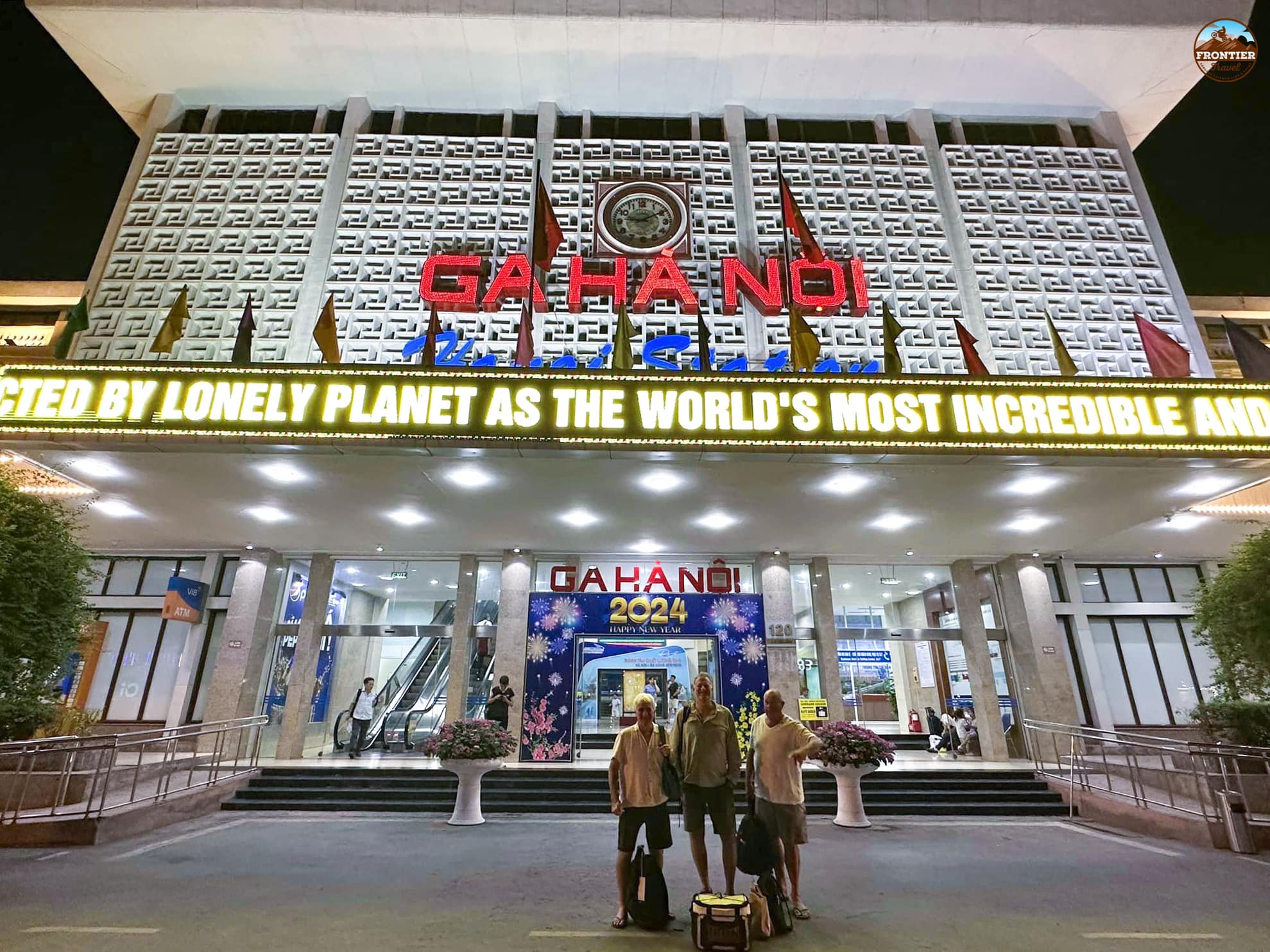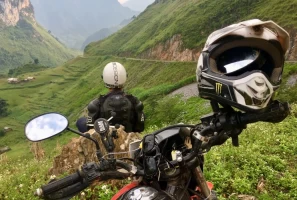Vietnam offers a diverse range of transportation options, making it easy to explore its stunning landscapes and vibrant cities. With well-connected international airports and straightforward land border crossings, getting to Vietnam is convenient. In this article, Frontier Travel Vietnam will present the top 7+ easy ways to travel around Vietnam in 2024, ensuring a smooth and enjoyable journey.
.png)
What is the most common transportation in Vietnam?
The most common transportation in Vietnam is the motorbike. Motorbikes are the preferred mode of travel for many locals due to their affordability, convenience, and ability to navigate through the country's often congested urban traffic. They are widely used for both short commutes within cities and longer journeys between towns.
7+ best way to travel around VietNam
Whether your priority is comfort, immersing yourself in local life, or maximizing your sightseeing opportunities, here are the top 7 easy ways to travel around Vietnam.
Long distance transport in Vietnam
Vietnam's elongated shape spans over 1,700 kilometers from its northern to southern regions. To traverse this distance, travelers typically opt for one of two primary modes of transportation:
Travel by airplane
For those with limited time, flying proves the most convenient travel option. Notably, the train journey from Hanoi to Ho Chi Minh City can span up to 30 hours, making air travel a preferable choice for maximizing your time. Domestic flight prices are surprisingly reasonable, with daily flights servicing all major destinations nationwide. Vietnam Airlines, alongside VietJet, Bamboo Airways, Vietravel Airlines, and Pacific Airlines, provide affordable options for short-haul flights across the country.

Travel by train
When it comes to covering long distances in Vietnam, traveling by train emerges as an affordable and practical choice. The Reunification Express trains operate daily, traversing the nation's extensive 3,000 kilometers of railway track between Saigon and Hanoi.

Each train car is equipped with sleeping compartments, featuring multiple bunk beds complete with blankets and pillows. For a slightly higher fare, passengers can opt for cabins with fewer bunks, ensuring a more private experience.
Ample storage space is available under the bunks for luggage, while restrooms and sinks are conveniently located at one end of each train car, accessible to all passengers. With their cozy amenities and scenic routes, these sleeper trains promise a journey well worth embarking on!
Local transport in Vietnam
With a booming tourism industry and numerous enticing destinations, the demand for transportation in Vietnam is at an all-time high. Here are some popular options to consider:
Boats & Cruises in Vietnam

Vietnam's waterways offer a mesmerizing way to explore its enchanting landscapes and vibrant culture. From the tranquil rivers to the stunning lakes, there's a plethora of options for those drawn to discovering Vietnam by boat.
For a rustic and traditional experience, consider navigating on a rowing boat, still used by fishermen today, offering a unique way to traverse short distances. If you seek a more personalized adventure, hop aboard a round basket boat, popular among tourists for their novelty and charm. In destinations like Hoi An, drifting along the Mekong amidst local fishermen provides an unforgettable experience, albeit not the most efficient mode of transport.
For an immersive journey along the Mekong, embark on a Mekong River Cruise, ranging from small speed boats to luxurious cruise ships, offering unparalleled vistas of the region's beauty.
In northern Vietnam, Halong Bay cruises are a must-do experience. Traditional boats converted into tour vessels provide comfortable cabins, delightful dining experiences, and breathtaking views of the bay's limestone formations. As you cruise, witness the lives of locals, some of whom reside on larger fishing boats or floating cabanas, adding an authentic touch to your voyage.
Travel by cars in Viet Nam

Traveling by private car in Vietnam offers a convenient and flexible way to explore the country, especially its remote areas. Whether you choose to drive yourself with a valid license or opt for a car rental with a driver, you'll have the freedom to set your own pace and visit destinations on your own schedule.
Car rental prices in Vietnam typically range from $25 to $100 USD per day, depending on factors such as the type of vehicle, rental duration, location, and additional services. Luxury or specialty vehicles may incur higher rental rates.
Here are some common car options along with their reference prices:
- 4-seat cars: $25 - $50 USD
- 7-seat cars: $40 - $80 USD
- 16-seater van: $60 - $100 USD
- SUV: $50 - $100 USD
With a private car, you can embark on memorable road trips across Vietnam, enjoying the scenic landscapes and discovering hidden gems along the way.
Travel by motorbike

As the most popular means of transportation in Vietnam, motorbikes are ideal for navigating both urban and rural areas. In bustling cities like Ho Chi Minh City and Hanoi, where roads are busy and narrow, motorbikes provide the best accessibility. For adventurous travelers, motorbikes also offer a thrilling option for long-distance journeys, allowing you to soak in breathtaking views.
Traveling by motorcycle grants you flexibility and freedom, letting you explore at your own pace, enjoy the wonders of nature, and interact with locals, all while saving costs. However, new riders should exercise caution and observe the local driving style, which can be unconventional.
Motorbike rental shops are abundant in most cities, with prices typically ranging from $15 to $35 per day, depending on the type and quality of the vehicle. To legally ride a motorcycle in Vietnam, ensure you have your national license along with an international driving permit.
Travel by bicycle

Cycling is a fantastic way to explore Vietnam at a relaxed pace, especially in its rural regions. Renting a bicycle lets you navigate quiet roads, charming villages, rice paddies, and beautiful landscapes, providing an immersive experience of the country's natural beauty. Bicycles can be rented in most cities, with rental fees usually ranging from $2 to $4 per day. This budget-friendly and eco-friendly option allows for a unique and intimate journey through Vietnam.
Travel by taxis

Taxis are a popular option for transportation within Vietnamese cities, offering a safe and efficient way to travel with multiple passengers. Taking a taxi provides greater control over your schedule and enhances safety, as taxis are driven by well-trained professionals with years of experience.
Here are some tips to keep in mind when taking a taxi:
- Choose reliable companies: Beware of unauthorized taxis and opt for reputable companies such as Mai Linh or Vinasun, which are known for their reliability.
- Check prices in advance: Research the prices of different taxi companies to find the best option for your route and budget.
- Document details: Take a photo of the taxi’s license plate and save the driver’s number in case you leave any belongings behind.
Extra Notes on Getting Around Vietnam
- Airport pick-up: To avoid potential taxi issues, especially after a long and exhausting flight, consider booking an airport pick-up through a tour company or your hotel.
- Road conditions and hazards: Be cautious of Vietnam's road conditions, as road safety is not a strong suit. The intercity roads, often two-lane highways, can be perilous with frequent head-on or high-speed collisions.
- Street crossing tips: Crossing the street can be daunting for first-time travelers. Instead of rushing, walk slowly and steadily, allowing local motorcyclists to navigate around you.
- Traffic jams in Vietnam: Navigating through rural areas in Vietnam is typically less challenging than in its bustling cities. Traffic jams are a frequent occurrence in Hanoi and Ho Chi Minh City, with locals well-accustomed to these congested conditions. To avoid traffic jams, consider traveling during off-peak hours or using alternative routes. Additionally, using motorcycles or bicycles can help you maneuver through traffic more easily and reach your destination faster.
- Motorcycle travel: If you plan to travel to the countryside or remote destinations by motorcycle, thoroughly research your route or consider hiring a local tour guide, as not all routes are well-mapped.
Vietnam offers diverse transportation options, from motorbikes and bicycles to boats and private cars, facilitating exploration of its stunning landscapes and vibrant cities. Whether you prefer the convenience of flying, the charm of train journeys, or the freedom of motorbike trips, there's a perfect way to discover the country's beauty. Plan your trip today and embark on a memorable journey with Frontier Travel Vietnam.









.png)